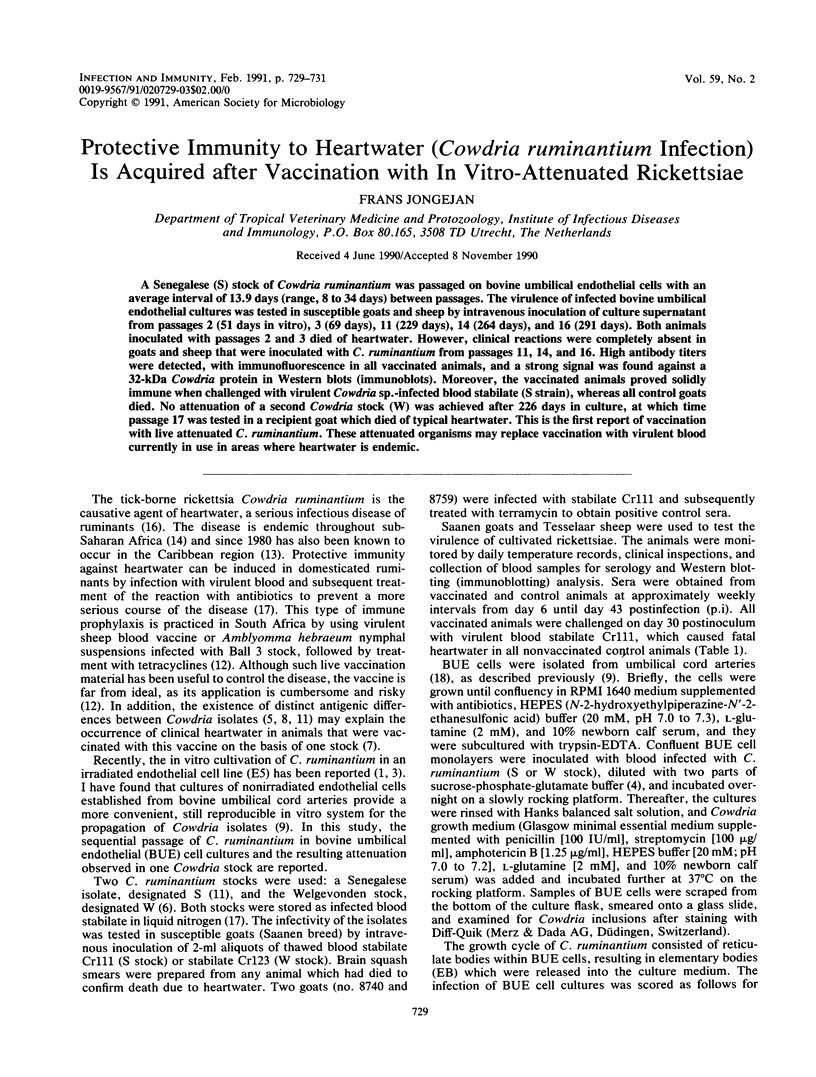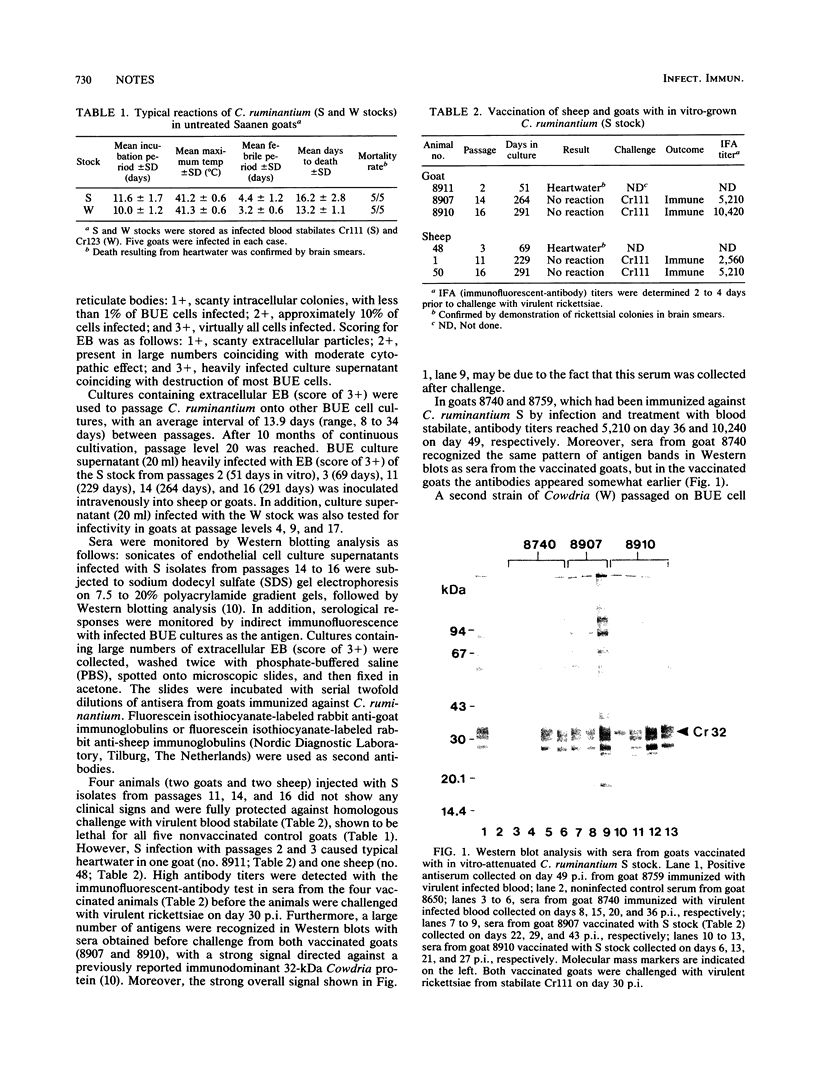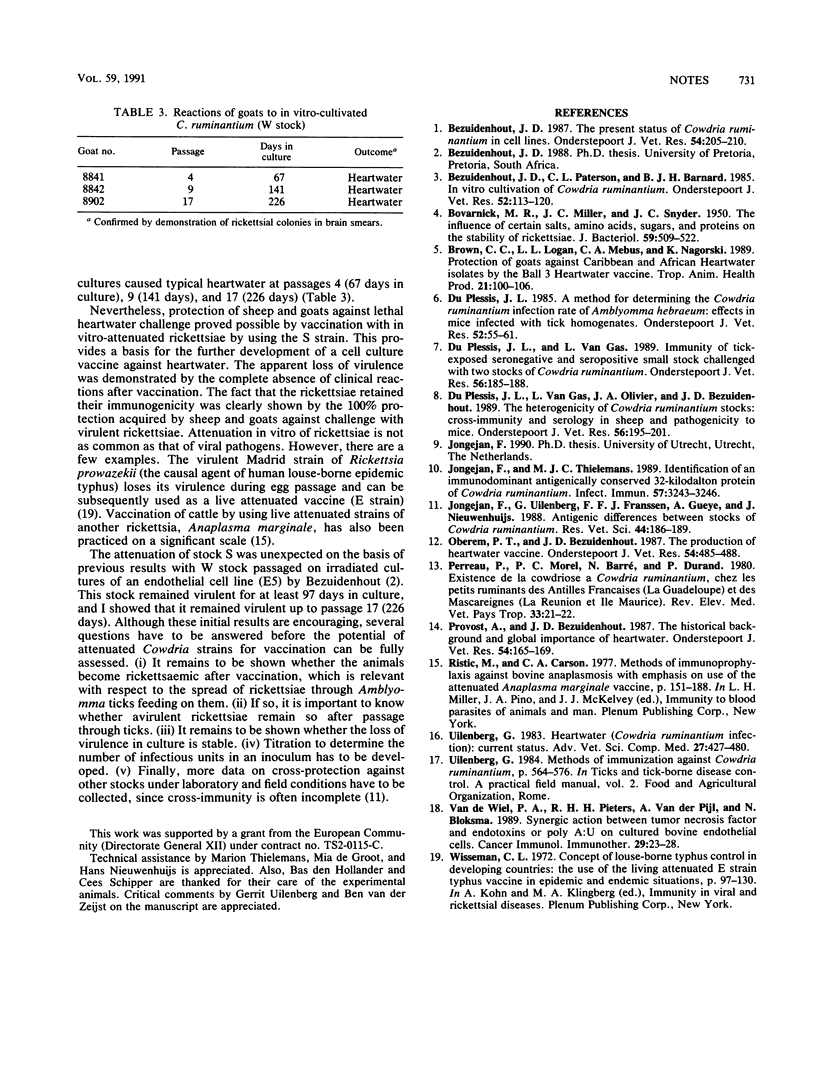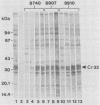Abstract
A Senegalese (S) stock of Cowdria ruminantium was passaged on bovine umbilical endothelial cells with an average interval of 13.9 days (range, 8 to 34 days) between passages. The virulence of infected bovine umbilical endothelial cultures was tested in susceptible goats and sheep by intravenous inoculation of culture supernatant from passages 2 (51 days in vitro), 3 (69 days), 11 (229 days), 14 (264 days), and 16 (291 days). Both animals inoculated with passages 2 and 3 died of heartwater. However, clinical reactions were completely absent in goats and sheep that were inoculated with C. ruminantium from passages 11, 14, and 16. High antibody titers were detected, with immunofluorescence in all vaccinated animals, and a strong signal was found against a 32-kDa Cowdria protein in Western blots (immunoblots). Moreover, the vaccinated animals proved solidly immune when challenged with virulent Cowdria sp.-infected blood stabilate (S strain), whereas all control goats died. No attenuation of a second Cowdria stock (W) was achieved after 226 days in culture, at which time passage 17 was tested in a recipient goat which died of typical heartwater. This is the first report of vaccination with live attenuated C. ruminantium. These attenuated organisms may replace vaccination with virulent blood currently in use in areas where heartwater is endemic.
Full text
PDF


Images in this article
Selected References
These references are in PubMed. This may not be the complete list of references from this article.
- BOVARNICK M. R., MILLER J. C., SNYDER J. C. The influence of certain salts, amino acids, sugars, and proteins on the stability of rickettsiae. J Bacteriol. 1950 Apr;59(4):509–522. doi: 10.1128/jb.59.4.509-522.1950. [DOI] [PMC free article] [PubMed] [Google Scholar]
- Bezuidenhout J. D., Paterson C. L., Barnard B. J. In vitro cultivation of Cowdria ruminantium. Onderstepoort J Vet Res. 1985 Jun;52(2):113–120. [PubMed] [Google Scholar]
- Bezuidenhout J. D. The present state of Cowdria ruminantium cultivation in cell lines. Onderstepoort J Vet Res. 1987 Sep;54(3):205–210. [PubMed] [Google Scholar]
- Brown C. C., Logan L. L., Mebus C. A., Nagorski K. Protection of goats against Caribbean and African heartwater isolates by the Ball 3 heartwater vaccine. Trop Anim Health Prod. 1989 May;21(2):100–106. doi: 10.1007/BF02236186. [DOI] [PubMed] [Google Scholar]
- Du Plessis J. L. A method for determining the Cowdria ruminantium infection rate of Amblyomma hebraeum: effects in mice injected with tick homogenates. Onderstepoort J Vet Res. 1985 Jun;52(2):55–61. [PubMed] [Google Scholar]
- Du Plessis J. L., Van Gas L. Immunity of tick-exposed seronegative and seropositive small stock challenged with two stocks of Cowdria ruminantium. Onderstepoort J Vet Res. 1989 Sep;56(3):185–188. [PubMed] [Google Scholar]
- Du Plessis J. L., Van Gas L., Olivier J. A., Bezuidenhout J. D. The heterogenicity of Cowdria ruminantium stocks: cross-immunity and serology in sheep and pathogenicity to mice. Onderstepoort J Vet Res. 1989 Sep;56(3):195–201. [PubMed] [Google Scholar]
- Jongejan F., Thielemans M. J. Identification of an immunodominant antigenically conserved 32-kilodalton protein from Cowdria ruminantium. Infect Immun. 1989 Oct;57(10):3243–3246. doi: 10.1128/iai.57.10.3243-3246.1989. [DOI] [PMC free article] [PubMed] [Google Scholar]
- Jongejan F., Uilenberg G., Franssen F. F., Gueye A., Nieuwenhuijs J. Antigenic differences between stocks of Cowdria ruminantium. Res Vet Sci. 1988 Mar;44(2):186–189. [PubMed] [Google Scholar]
- Oberem P. T., Bezuidenhout J. D. The production of heartwater vaccine. Onderstepoort J Vet Res. 1987 Sep;54(3):485–488. [PubMed] [Google Scholar]
- Perreau P., Morel P. C., Barre N., Durand P. Existence de la cowdriose (heartwater) à Cowdria ruminantium chez les ruminants des Antilles françaises (la Guadeloupe) et des Mascareignes (la Réunion et Ile Maurice). Rev Elev Med Vet Pays Trop. 1980;33(1):21–22. [PubMed] [Google Scholar]
- Provost A., Bezuidenhout J. D. The historical background and global importance of heartwater. Onderstepoort J Vet Res. 1987 Sep;54(3):165–169. [PubMed] [Google Scholar]
- Ristic M., Carson C. A. Methods of immunoprophylaxis against bovine anaplasmosis with emphasis on use of the attenuated Anaplasma marginale vaccine. Adv Exp Med Biol. 1977;93:151–188. doi: 10.1007/978-1-4615-8855-9_10. [DOI] [PubMed] [Google Scholar]
- Uilenberg G. Heartwater (Cowdria ruminantium infection): current status. Adv Vet Sci Comp Med. 1983;27:427–480. [PubMed] [Google Scholar]
- Wisseman C. L., Jr Concepts of louse-borne typhus control in developing countries: the use of the living attenuated E strain typhus vaccine in epidemic and endemic situations. Adv Exp Med Biol. 1972;31(0):97–130. doi: 10.1007/978-1-4684-3225-1_9. [DOI] [PubMed] [Google Scholar]
- van de Wiel P. A., Pieters R. H., van der Pijl A., Bloksma N. Synergic action between tumor necrosis factor and endotoxins or poly(A.U) on cultured bovine endothelial cells. Cancer Immunol Immunother. 1989;29(1):23–28. doi: 10.1007/BF00199912. [DOI] [PMC free article] [PubMed] [Google Scholar]



